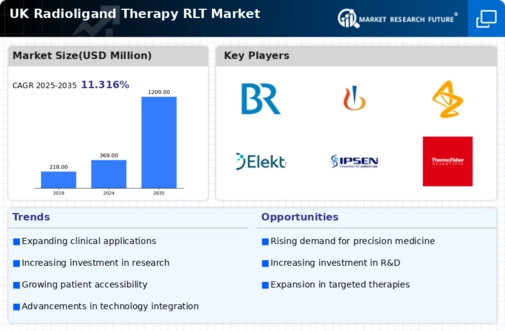The UK Radioligand Therapy Market (RLT) Market presents a dynamic and rapidly evolving landscape that is increasingly attracting interest from both established pharmaceutical companies and emerging biotech firms. This market is characterized by its potential to revolutionize treatment paradigms for diseases such as cancer, where precision medicine and targeted therapies are becoming crucial for better patient outcomes. The competitive insights within this domain highlight various strategies employed by companies, ranging from innovative drug development and strategic partnerships to regulatory navigation and market access initiatives.
As these entities vie for market share, understanding their competitive positioning, pipeline advancements, and challenges will be essential for stakeholders looking to capitalize on the opportunities presented by the RLT market in the UK.Bayer has established a notable presence in the UK Radioligand Therapy Market, leveraging its robust research capabilities and extensive experience in pharmaceuticals. The company's commitment to innovation is evident in its active development of radioligand therapies that align with unmet medical needs, particularly in oncology.
One of Bayer’s key strengths lies in its established reputation and strong branding in the healthcare sector, enabling it to engage effectively with both healthcare providers and patient communities.
Additionally, Bayer's collaborative approach in partnering with academic institutions and research organizations enhances its knowledge base and accelerates the development of its RLT offerings. This strategic engagement reinforces Bayer’s standing in the UK market, where its focus on delivering efficacious and targeted therapies positions it favorably among competitors.In the realm of the UK Radioligand Therapy Market, Novartis operations are characterized by their focus on innovative treatment options for cancer. The company has a diversified pipeline that includes radioligand therapies designed to address critical therapeutic areas, demonstrating a commitment to advancing patient care.
Novartis’s strengths in this market stem from its significant investment in research and development, which aids in the continuous evolution of its product offerings, keeping them aligned with the latest medical advancements. Moreover, Novartis has a history of strategic mergers and acquisitions that bolster its portfolio and enhance its market presence. By incorporating cutting-edge technologies and promising compounds into its repertoire, Novartis positions itself as a formidable player in the UK, emphasizing its commitment to improving survival outcomes for patients with complex diseases.
The combination of its strong portfolio, market adaptability, and focus on patient-centric solutions establishes Novartis as a key competitor in the UK's evolving radioligand therapy landscape.






















Leave a Comment